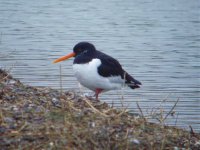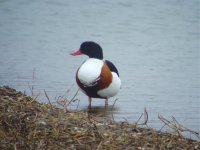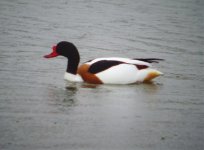-
Welcome to BirdForum, the internet's largest birding community with thousands of members from all over the world. The forums are dedicated to wild birds, birding, binoculars and equipment and all that goes with it.
Please register for an account to take part in the discussions in the forum, post your pictures in the gallery and more.
You are using an out of date browser. It may not display this or other websites correctly.
You should upgrade or use an alternative browser.
You should upgrade or use an alternative browser.
Upton Warren (11 Viewers)
- Thread starter andythomas
- Start date
More options
Who Replied?Woodchat
Cogito ergo sum
28/02/10 Morning Session
My target bird for the morning came virtually instantly - a Raven flew over the Moors farmhouse and low over the paddock. The RCP's have departed the Moors Pool but a Little Grebe was present and 4 Lesser Redpolls were opposite Lifestyles feeding on Alder cones with Goldfinches.
At least 15 further Redpolls were in the Education Reserve along with Treecreeper and G.S. Woodpecker.
The Oystercatcher was on the Flashes with a pair of Shelduck (see Photos attached).
Year list: 78
Will be back later this afternoon......
My target bird for the morning came virtually instantly - a Raven flew over the Moors farmhouse and low over the paddock. The RCP's have departed the Moors Pool but a Little Grebe was present and 4 Lesser Redpolls were opposite Lifestyles feeding on Alder cones with Goldfinches.
At least 15 further Redpolls were in the Education Reserve along with Treecreeper and G.S. Woodpecker.
The Oystercatcher was on the Flashes with a pair of Shelduck (see Photos attached).
Year list: 78
Will be back later this afternoon......
Attachments
matt green
Norfolkman gone walkabout
The RCP's have departed the Moors Pool
Surely they were plastic anyway, escapees from a wildfowl collection and non tickable?
Matt
wheatearlp
Well-known member

Surely they were plastic anyway, escapees from a wildfowl collection and non tickable?
Matt
What makes you say that? Are you suggesting all records of RCPs in Britain are plastic?
matt green
Norfolkman gone walkabout
What makes you say that? Are you suggesting all records of RCPs in Britain are plastic?
I was assuming most RCP's spotted in the UK are either escapee birds or ferally breeding birds rather than genuine vagrants from Europe. This is certainly the case in Norfolk, where they seem to spring up everywhere in suitable habitat ...along with Ruddy Shelduck etc. To be honest I wouldn't give one a second glance in Norfolk....
Would be interesting to see if the record gets accepted by your county recorder and gets included in next years west midlands bird and mammel report.
Matt
Brian Stretch
Well-known member
I was assuming most RCP's spotted in the UK are either escapee birds or ferally breeding birds rather than genuine vagrants from Europe. This is certainly the case in Norfolk, where they seem to spring up everywhere in suitable habitat ...along with Ruddy Shelduck etc. To be honest I wouldn't give one a second glance in Norfolk....
Would be interesting to see if the record gets accepted by your county recorder and gets included in next years west midlands bird and mammel report.
Matt
Already accepted by the county recorder and entered in to the draft 2010 report. Unringed, fully winged, one day birds, photographed and multi-observed - as good a record as you could hope to obtain. The UK's stronghold for this species is just down the road in the Cotswold Water Park, where no doubt most of our birds originate. Many of these dispersed during the January cold spell and ended up all over the Midlands and beyond, eg c80 were at Rutland Water in January where they normally only get a few and up to eight were at Bredon's Hardwick, which is a good count for Worcestershire.
I would give them a second look if I was in Norfolk. You have a better chance of getting some genuine birds from the continent although there are (were) some free-flying 'captive' birds at places like Pensthorpe.
Brian
__________________________
www.birdingtoday.co.uk
www.worcesterbirding.co.uk
www.westmidlandsbirding.co.uk
Last edited:
Gert Corfield
Well-known member

I was assuming most RCP's spotted in the UK are either escapee birds or ferally breeding birds rather than genuine vagrants from Europe. This is certainly the case in Norfolk, where they seem to spring up everywhere in suitable habitat ...along with Ruddy Shelduck etc. To be honest I wouldn't give one a second glance in Norfolk....
Would be interesting to see if the record gets accepted by your county recorder and gets included in next years west midlands bird and mammel report.
Matt
An interesting point Matt. The BOU categorise RCP as a species having been recorded in apparently natural state at least once since 1/1/1950 (A) and as a Naturalised re-established species with established populations resulting from introductions by man, but which also occur in an apparently natural state (C2).
In addition it is categorised under E* ie birds of known or presumed captive origin that breed in the wild in Britain or Ireland.
Its status code under the BOU is NB (naturalised breeder) and SM (scarce migrant).
I certainly gave them a second look - the drakes especially are beautiful! As to whether or not to tick I guess thats a personal choice - if I didn't (as far as my Upton list is concerned) should I tick Canada Goose, Pheasant, Red legged partridge etc etc ?
Last edited:
Martyn Yapp
Well-known member
Alas a minefield when it comes to birds like RCP, a stunning bird that really looks more in place in southern Europe and Asia, but natural vagrancy must occur, so it is rather down to the individual as what to do with them on their list, but a generally an accepted tick, regionally or nationally.
Now when it come to Barnacle Geese thats a different matter!
I must confess to really wonder where our Osprey's and Red Kite's now originate from, unless you saw one pre-reintroduction scheme, can you be totally sure what you are seeing.
Now when it come to Barnacle Geese thats a different matter!
I must confess to really wonder where our Osprey's and Red Kite's now originate from, unless you saw one pre-reintroduction scheme, can you be totally sure what you are seeing.
An interesting point Matt. The BOU categorise RCP as a species having been recorded in apparently natural state at least once since 1/1/1950 (A) and as a Naturalised re-established species with established populations resulting from introductions by man, but which also occur in an apparently natural state (C2).
In addition it is categorised under E* ie birds of known or presumed captive origin that breed in the wild in Britain or Ireland.
Its status code under the BOU is NB (naturalised breeder) and SM (scarce migrant).
I certainly gave them a second look - the drakes especially are beautiful! As to whether or not to tick I guess thats a personal choice - if I didn't (as far as my Upton list is concerned) should I tick Canada Goose, Pheasant, Red legged partridge etc etc ?
wheatearlp
Well-known member

I was assuming most RCP's spotted in the UK are either escapee birds or ferally breeding birds rather than genuine vagrants from Europe.
I don't think anyone is for a moment suggesting many, or indeed any, RCPs in Worcs are genuine vagrants from any of the recognised wild breeding populations in Europe. However, as pointed out in subsequent posts, they are also categorised by the BOU in Cat C2 and there is an established feral breeding population in the Cotswold Water Park. I would suggest that it is more likely that these birds, and others seen in the county over the last 18 months or so, have come from there rather than from a collection. Therefore I wouldn't categorise them as plastic - my interpretation of that being stuff that has patently escaped from a collection, e.g. Ringed Teal, Hottentot Teal, Cape Teal, all of which have been recorded in Worcs, or something identified by some means as having definitely escaped from a collection.
On those grounds I would count them as Cat C2 sightings. What you choose to do regarding your sightings in Norfolk, or elsewhere, is of course entirely up to you - are you disregarding Cat C2 or do you not think any of your sightings originate from such populations?
Mike
Woodchat
Cogito ergo sum
28/02/10 Afternoon Session
Not much added this afternoon with things appearing somewhat static today cf. yesterday. A Goldcrest was present in the conifers bordering the gardens along the east path on the Moors. The Little Egret and Oystercatcher were around Amy's.
Two Treecreepers were in the education reserve. Forgot to mention in my earlier post, a Meadow Pipit flew over the field in front of Hobden Hall Farm this morning.
The flashes roost was disappointing with roughly only about half the number of BHG's compared with yesterday ~320 birds. A Herring Gull flew over the sailing lake and a couple of LBB's were on the Moors.
Not much added this afternoon with things appearing somewhat static today cf. yesterday. A Goldcrest was present in the conifers bordering the gardens along the east path on the Moors. The Little Egret and Oystercatcher were around Amy's.
Two Treecreepers were in the education reserve. Forgot to mention in my earlier post, a Meadow Pipit flew over the field in front of Hobden Hall Farm this morning.
The flashes roost was disappointing with roughly only about half the number of BHG's compared with yesterday ~320 birds. A Herring Gull flew over the sailing lake and a couple of LBB's were on the Moors.
Gert Corfield
Well-known member

Not much added this afternoon with things appearing somewhat static today cf. yesterday. A Goldcrest was present in the conifers bordering the gardens along the east path on the Moors. The Little Egret and Oystercatcher were around Amy's.
Two Treecreepers were in the education reserve. Forgot to mention in my earlier post, a Meadow Pipit flew over the field in front of Hobden Hall Farm this morning.
The flashes roost was disappointing with roughly only about half the number of BHG's compared with yesterday ~320 birds. A Herring Gull flew over the sailing lake and a couple of LBB's were on the Moors.
Phew - glad I didn't miss anything! Mind you the weather didn't materialise as forecast...
Gert Corfield
Well-known member

I don't think anyone is for a moment suggesting many, or indeed any, RCPs in Worcs are genuine vagrants from any of the recognised wild breeding populations in Europe. However, as pointed out in subsequent posts, they are also categorised by the BOU in Cat C2 and there is an established feral breeding population in the Cotswold Water Park. I would suggest that it is more likely that these birds, and others seen in the county over the last 18 months or so, have come from there rather than from a collection. Therefore I wouldn't categorise them as plastic - my interpretation of that being stuff that has patently escaped from a collection, e.g. Ringed Teal, Hottentot Teal, Cape Teal, all of which have been recorded in Worcs, or something identified by some means as having definitely escaped from a collection.
On those grounds I would count them as Cat C2 sightings. What you choose to do regarding your sightings in Norfolk, or elsewhere, is of course entirely up to you - are you disregarding Cat C2 or do you not think any of your sightings originate from such populations?
Mike
Mike - perhaps we should agree on what basis we are ticking Upton birds - according to BOU categories? Exclude all C and E* ? Lets not go there haha!
matt green
Norfolkman gone walkabout
Already accepted by the county recorder and entered in to the draft 2010 report. Unringed, fully winged, one day birds, photographed and multi-observed - as good a record as you could hope to obtain. The UK's stronghold for this species is just down the road in the Cotswold Water Park, where no doubt most of our birds originate. Many of these dispersed during the January cold spell and ended up all over the Midlands and beyond, eg c80 were at Rutland Water in January where they normally only get a few and up to eight were at Bredon's Hardwick, which is a good count for Worcestershire.
Brian
Thanks for the reply, Brian.
That just about clears that up then!!
Matt
matt green
Norfolkman gone walkabout
Mike - perhaps we should agree on what basis we are ticking Upton birds - according to BOU categories? Exclude all C and E* ? Lets not go there haha!
Or maybe even just watch them and enjoy them for what they are!!
*Gladly scuttles back to Norfolk*
Matt
Gert Corfield
Well-known member

Or maybe even just watch them and enjoy them for what they are!
Matt
I'm with you on that one Matt!:t:
Cheers
Gert
upstarts1979
Well-known member
Alas a minefield when it comes to birds like RCP, a stunning bird that really looks more in place in southern Europe and Asia, but natural vagrancy must occur, so it is rather down to the individual as what to do with them on their list, but a generally an accepted tick, regionally or nationally.
Now when it come to Barnacle Geese thats a different matter!
I must confess to really wonder where our Osprey's and Red Kite's now originate from, unless you saw one pre-reintroduction scheme, can you be totally sure what you are seeing.
I can tell you where the 5 Osprey's I have seen at upton came from and that is Africa or Scotland as they were all prior to the Rutland introduction scheme . I haven't seen Red kite at upton so as far as I am concerned it could be wales or oxford we will never know. My point is that once they have assimilated does it matter where they come from they were once a part of the UK avifauna.
With many southern european species moving north Little egret is a prime example, could Glossy ibis be the next...there are lots of species knocking on the door and if they all want to appear at upton thats ok by me.
My upton list 207 and counting
cheers John
mind you the lesser flamingo, sacred ibis, hottentot teal, and manx shearwater (released by a vet after it was rescued elsewhere) are not on my list actually I wonder if Brian will let me have the shearwater, it was flying around the Flashes and we didn't know it had been released:flowers:
Last edited:
Woodchat
Cogito ergo sum
I was assuming most RCP's spotted in the UK are either escapee birds or ferally breeding birds rather than genuine vagrants from Europe. This is certainly the case in Norfolk, where they seem to spring up everywhere in suitable habitat ...along with Ruddy Shelduck etc. To be honest I wouldn't give one a second glance in Norfolk....
Would be interesting to see if the record gets accepted by your county recorder and gets included in next years west midlands bird and mammel report.
Matt
Thanks for the above comments, Matt - they certainly have sparked some healthy debate. I agree that certain birds, especially wilfowl, are a little tainted by the prospect that they may be of dubious origin. However, I agree with the points made by Brian et al. above. I have no more problem with ticking these RCP's than I would ticking a Mandarin in the county, for instance. It's worth remembering that Gadwall in the UK are at least partially (mostly?) derived from introduced stock 150 years ago.
Woodchat
Cogito ergo sum
John. I remember that shearwater-- i'm awaiting a response from Brian.
I met Woodchat in the Education Reserve today. He kept distracting me with idle tittle-tattle. I must have missed about six possible Upton year ticks!
Des.
I specialise in 'idle tittle tattle'!
upstarts1979
Well-known member
Hi DesJohn. I remember that shearwater-- i'm awaiting a response from Brian.
I met Woodchat in the Education Reserve today. He kept distracting me with idle tittle-tattle. I must have missed about six possible Upton year ticks!
Des.
I told you its a tactic, they keep others occupied so they don't hear species that they have already got on the list. .:-O
Mind you at this rate I have heard but not seen 2 owl species lets hope I see the other 3 owls cause I don't think anyone will believe me if I just hear them.
Dave is streaking ahead now though
Similar threads
- Replies
- 1
- Views
- 1K






